Crusty Artisan Bread
This post may contain affiliate links. Read my full disclosure policy.
This crusty bread recipe is astonishingly easy—no kneading required—and makes three beautiful loaves, which you can bake as needed.
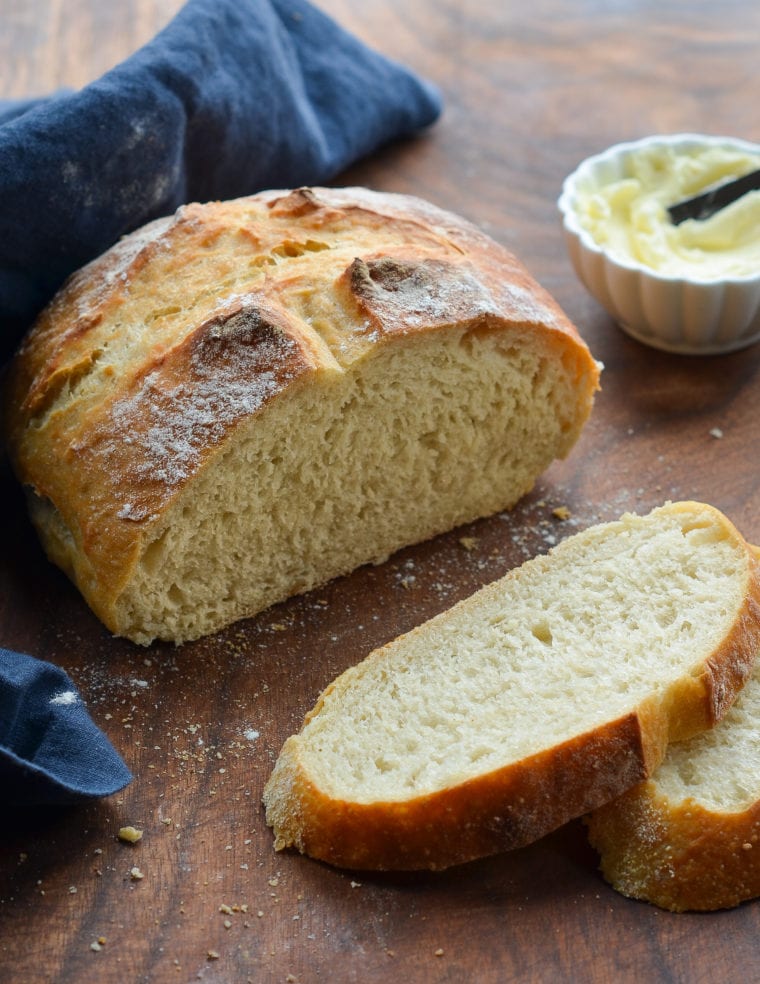
This homemade artisan bread recipe is astonishingly easy, and it makes enough for three delicious loaves, which you can bake as needed. What’s more, the dough takes just five minutes to make, does not require kneading or any special equipment, and can rest in the fridge for up to two weeks (the flavor becomes more complex the longer it sits). The recipe is modestly adapted from one of my favorite baking books, Artisan Bread in 5 Minutes A Day by Jeff Hertzberg M.D. and Zoë François.
Table of Contents
What You’ll Need To Make Crusty Artisan Bread
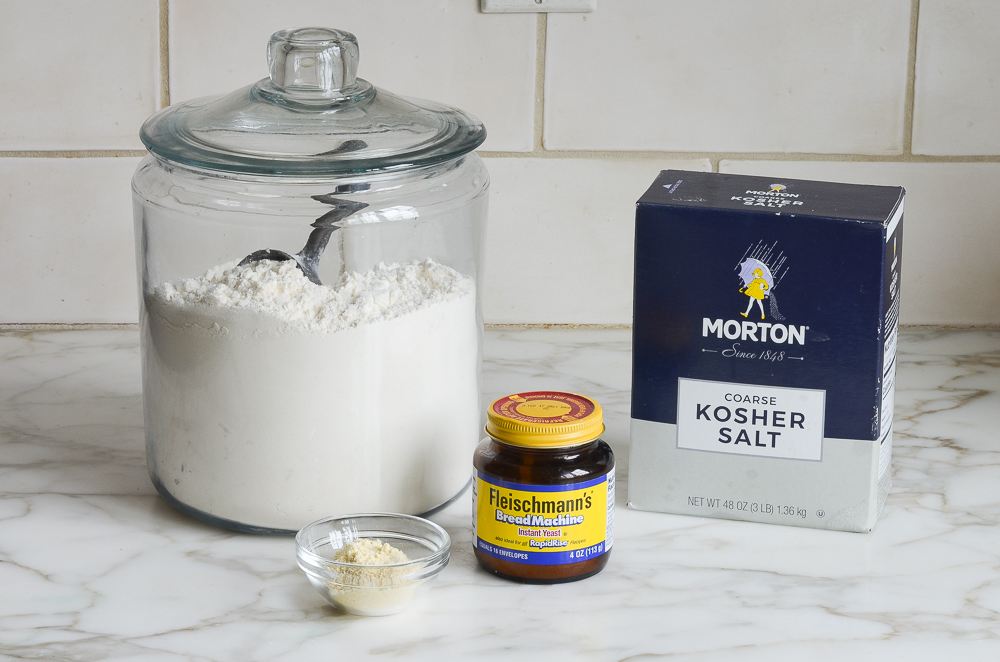
This recipe has just four ingredients: all-purpose flour, instant yeast, kosher salt, and water. (The cornmeal is for dusting the pan.) As you can see, I use instant (or rapid-rise) yeast. Active dry yeast may be used instead of instant yeast, however, the dough will take longer to rise. To give active dry yeast a boost, you can dissolve it in the lukewarm water and let it sit until frothy, about 10 minutes. After that, add it to the flour and proceed with the recipe.
How To Make Crusty Artisan Bread
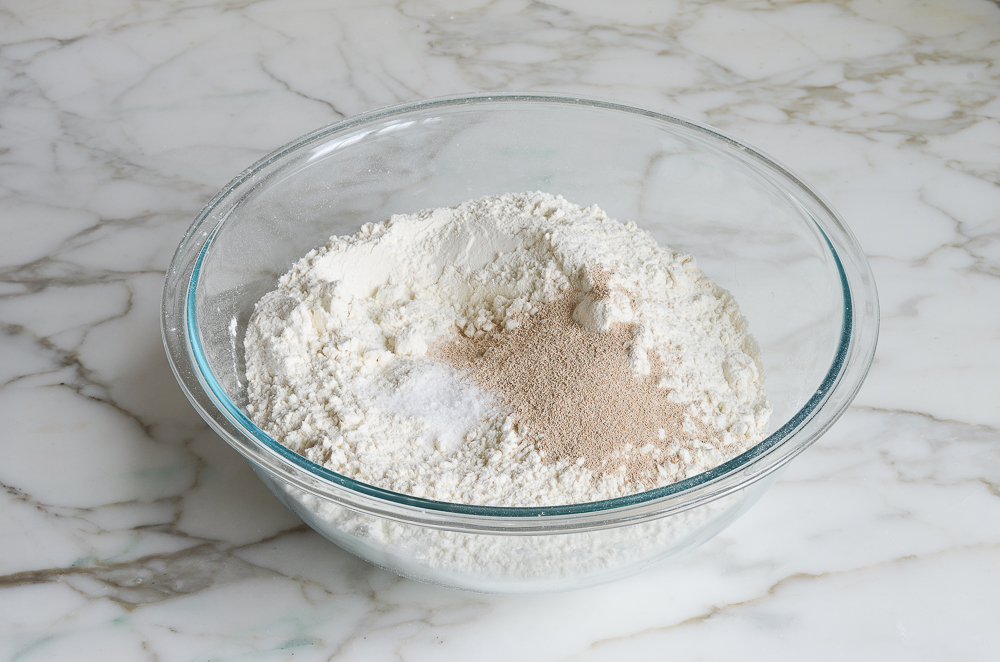
In a very large (6-quart) bowl, combine the flour, salt, and yeast. Mix to combine.
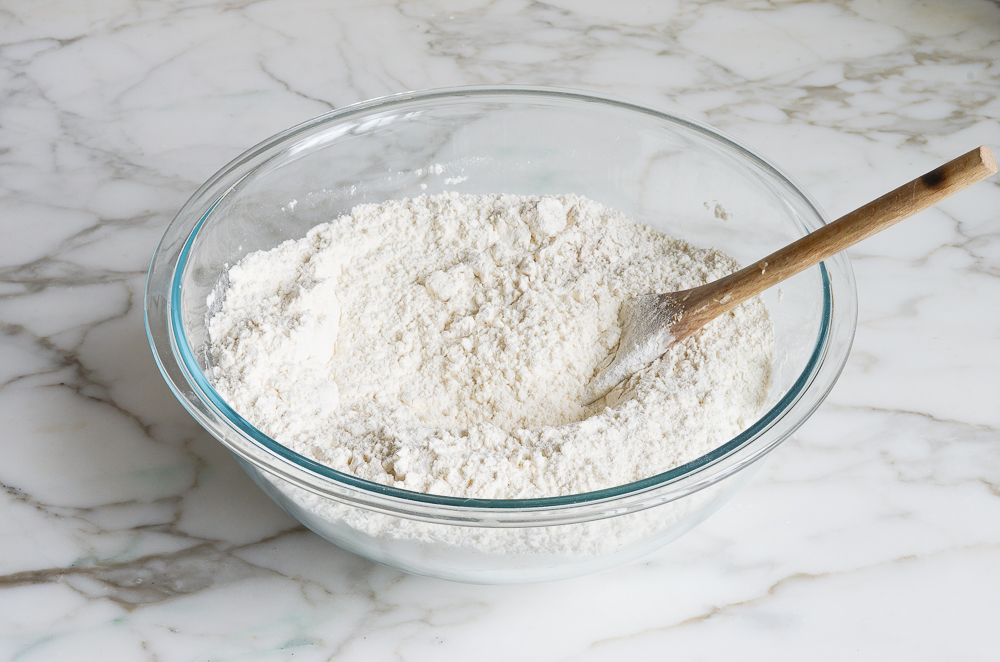
Add 3 cups of lukewarm water (no need to be exact but lukewarm is about 100°F).
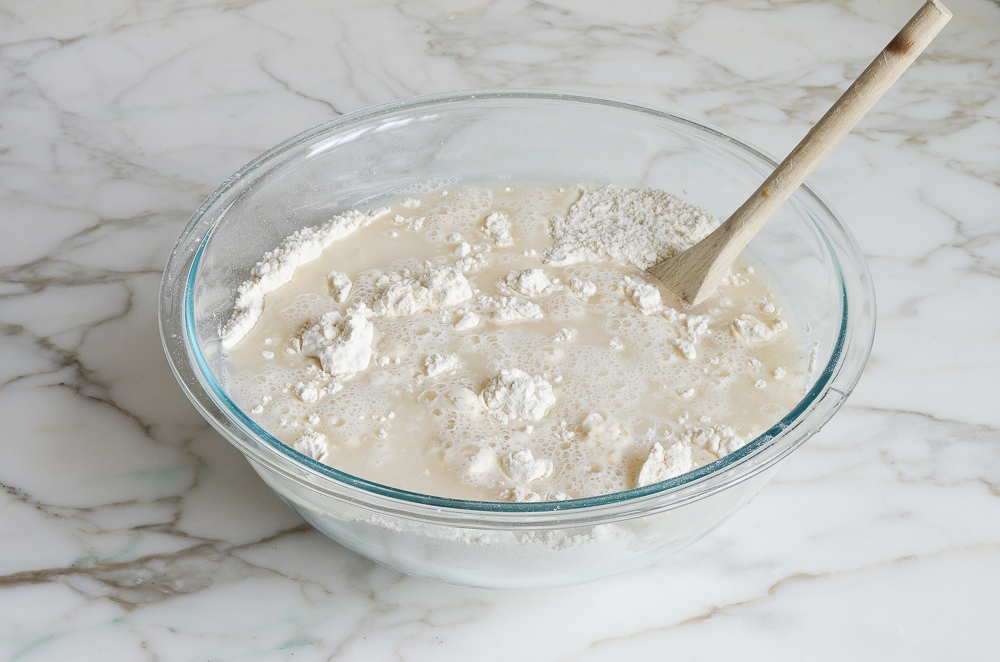
Stir with a wooden spoon until the mixture is uniformly moist, without any patches of flour.
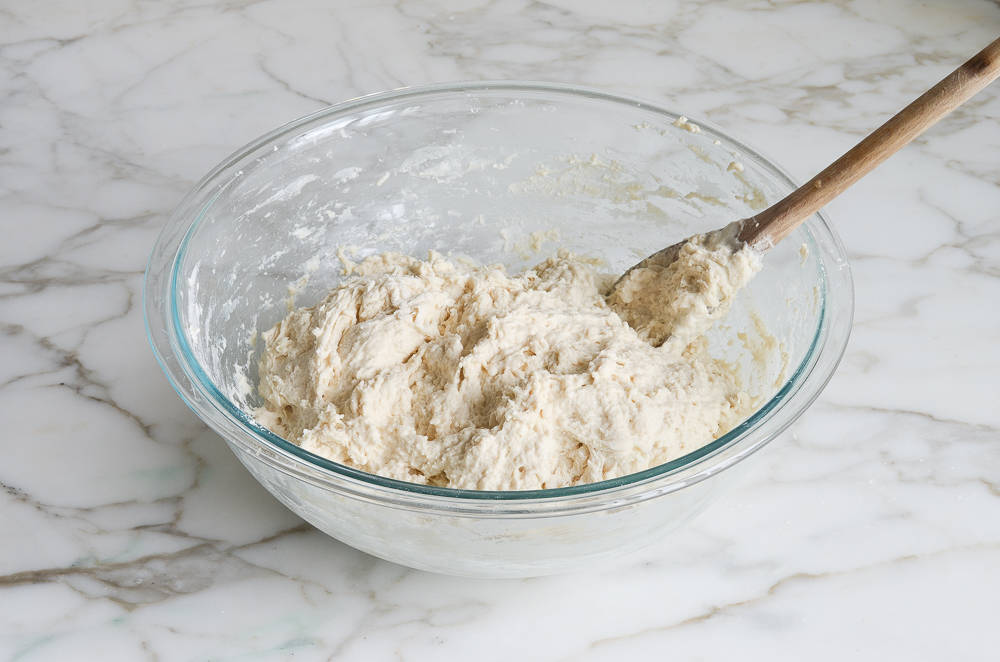
The dough should be sticky and conform to the shape of the bowl. If your dough is too dry, add a few tablespoons more warm water. If it’s too wet, add a few tablespoons of flour. Cover the bowl loosely with plastic wrap and let it sit on the counter in a warm spot for 2 hours. As you can see below, it will rise a lot!
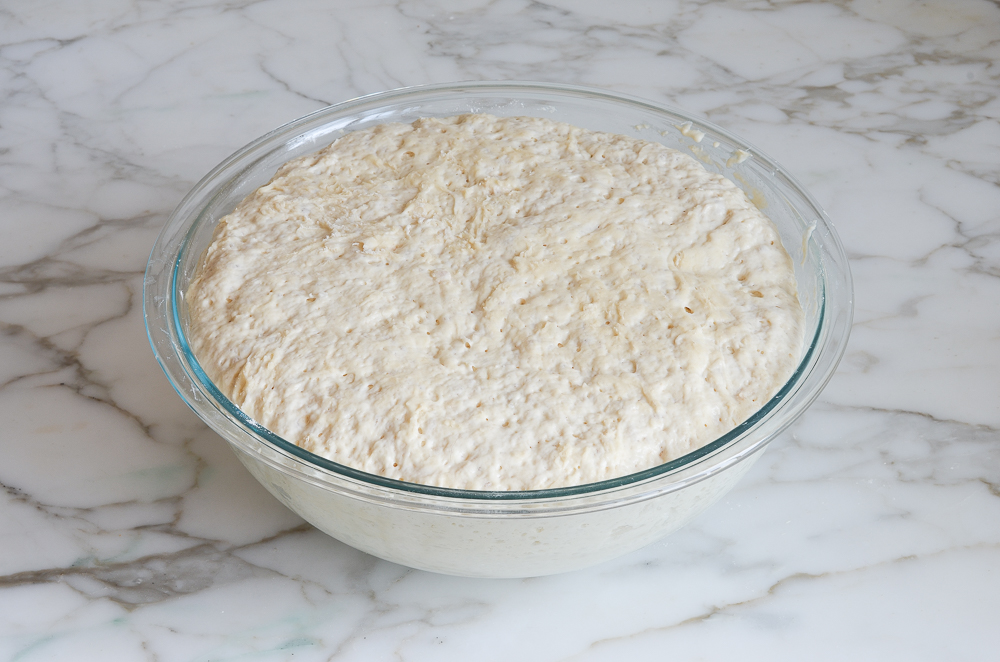
When you’re ready to bake a loaf, pull out one-third of the dough.
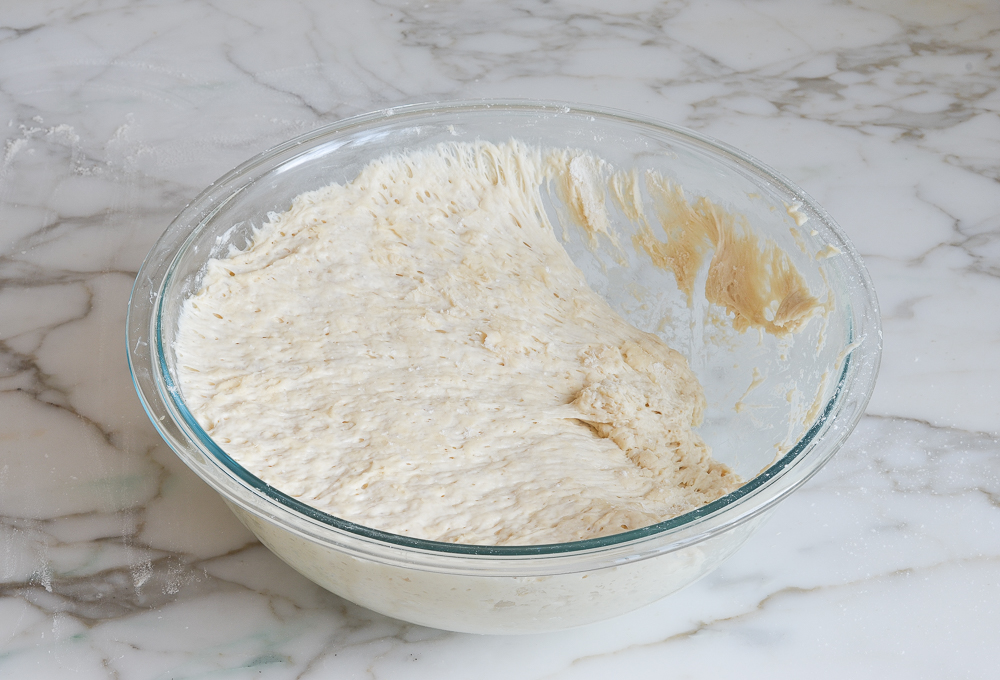
Coat the outside lightly with flour (you don’t want to incorporate more flour into the dough, you just want to be able to handle it). Gently work the dough into a smooth ball, stretching the surface and tucking the ends underneath.
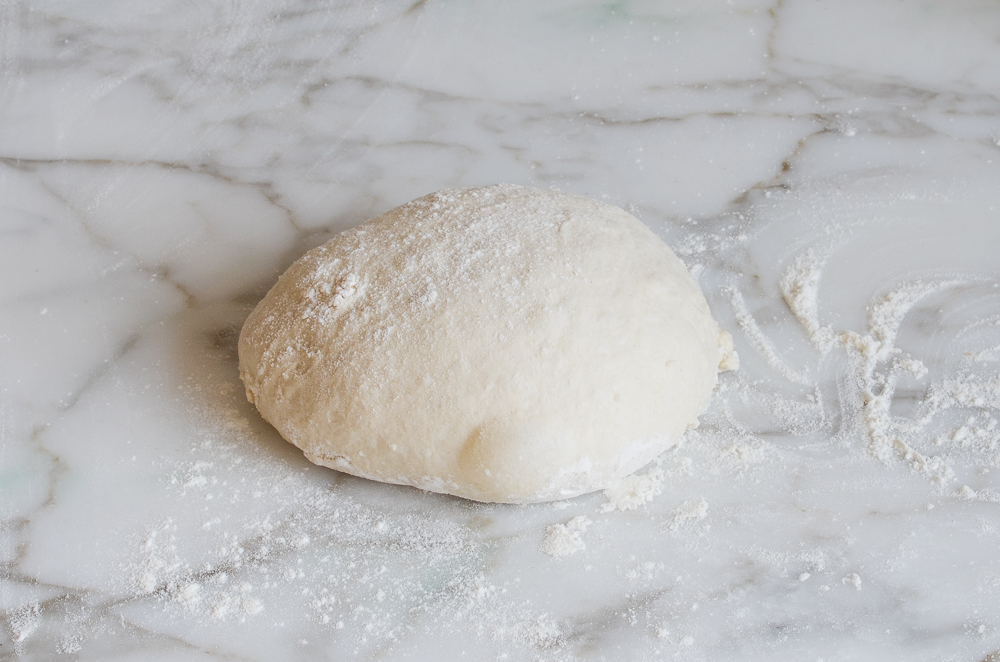
Put the dough ball onto a cornmeal-dusted baking sheet and let rest at room temperature, uncovered, for about 40 minutes. (If the dough has been refrigerated, allow it to rise for 60 minutes, or up to 90 minutes if you want a more open and airy crumb structure.) The dough will rise a bit. It may also spread/flatten a bit; that’s okay.
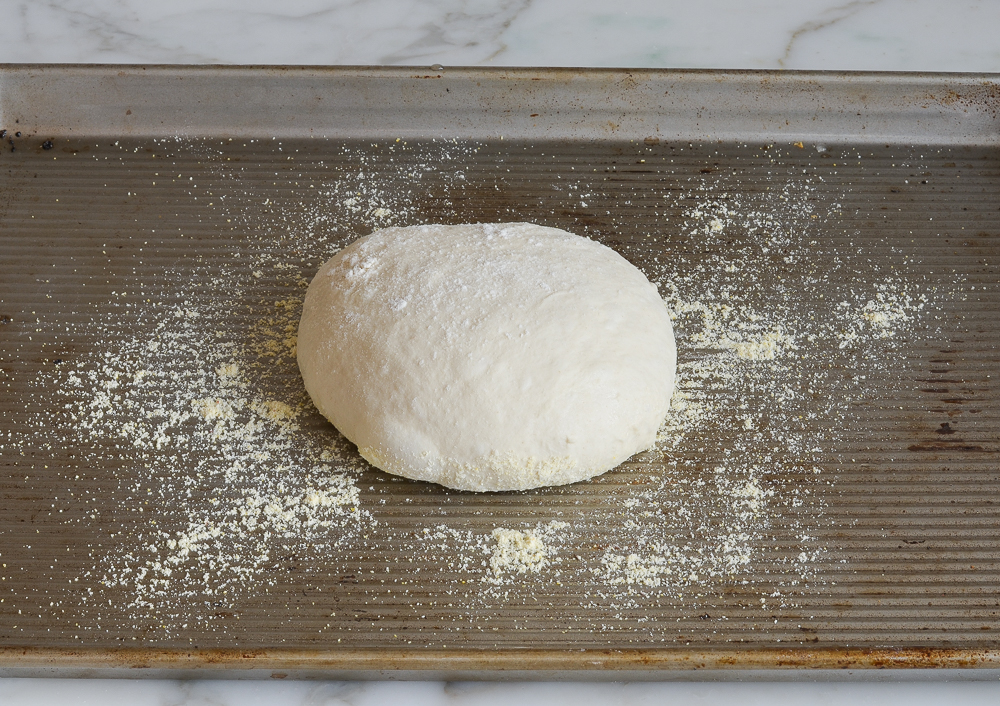
The dough will rise a bit.
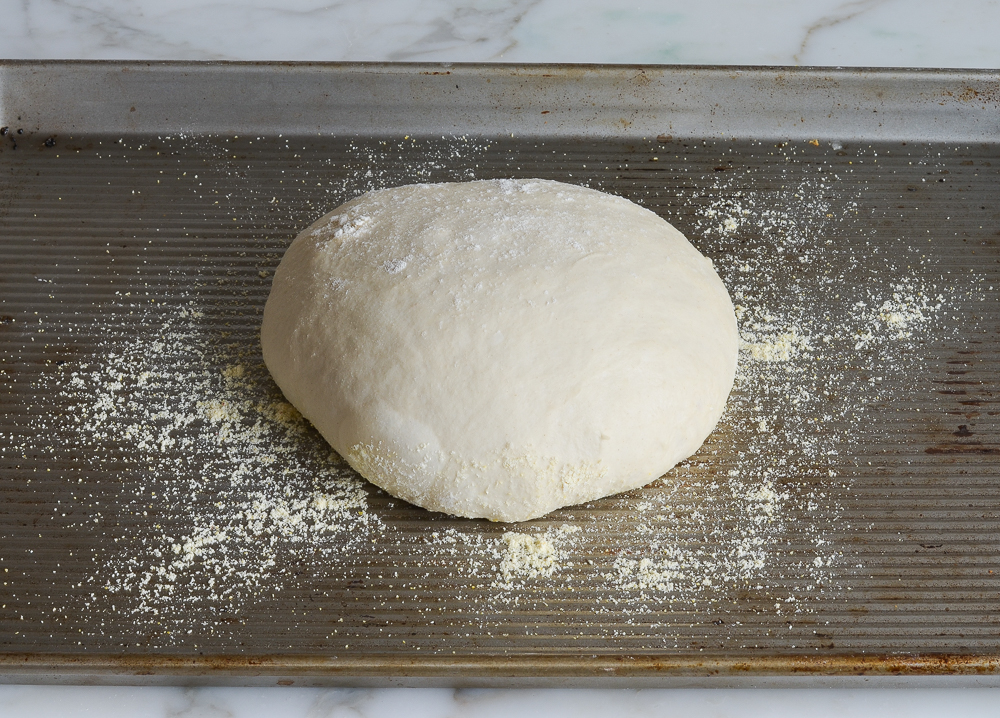
Generously dust the dough with flour. Using a sharp knife, make a few 1/2-inch-deep slashes in the dough — a scallop, cross, or tic tac toe pattern all look nice.
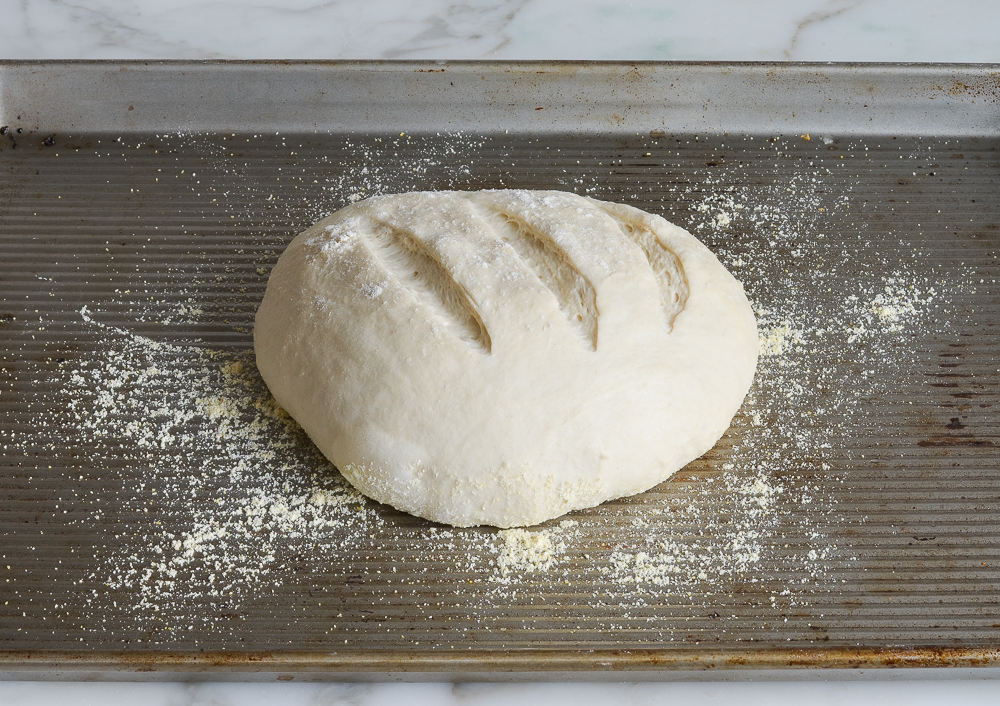
Set a metal pan on the bottom rack of a preheated 450°F-oven. Slide the baking sheet with the dough into the oven, and carefully fill the metal cake pan with one cup of hot tap water. This creates steam in the oven. (Try to do this quickly so as not to let heat out of the oven.) Bake until the loaf is golden brown, about 30 minutes. Cool completely on a wire rack.
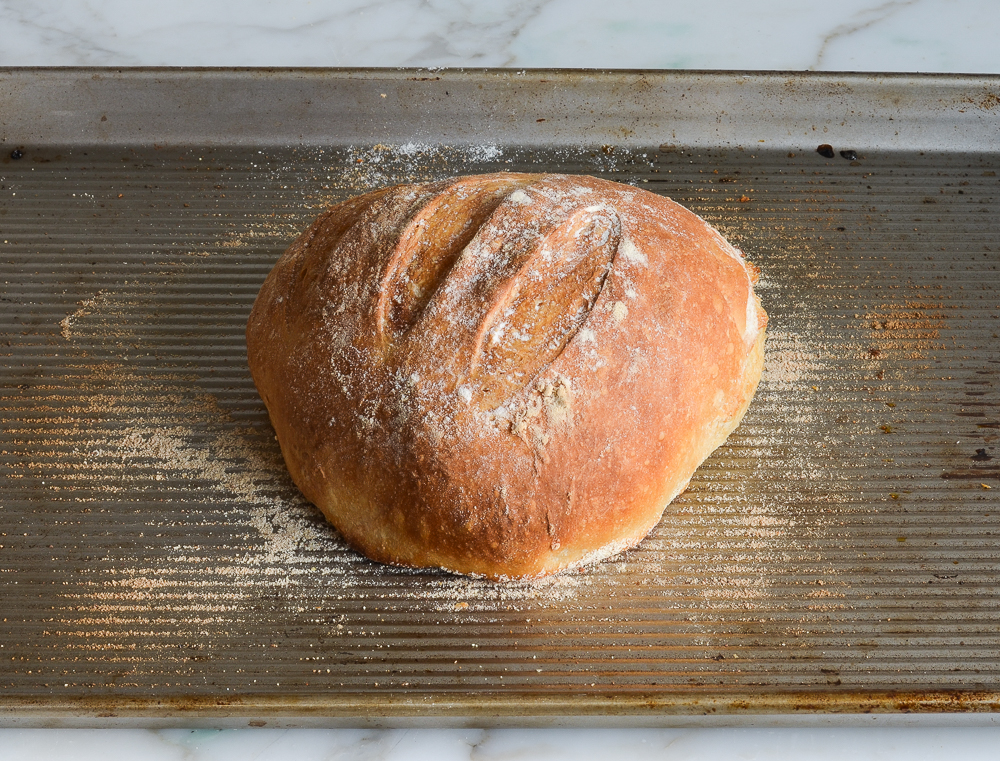
This bread is best enjoyed fresh on the day it is made. Once sliced, place the loaf cut-side down on a cutting board or plate and leave it uncovered.
How To Freeze
The dough can be portioned into thirds and frozen in airtight plastic containers for up to 1 month. Defrost the dough in the refrigerator overnight, then shape, rest and bake as usual. The baked loaves can also be frozen whole or sliced. Wrap in a zip-top freezer bag and freeze for up to 1 month. To thaw, take the bread out of the freezer and let it come to room temperature, about 3 hours. Reheat in a 350°F oven until warmed through, about 10 minutes.
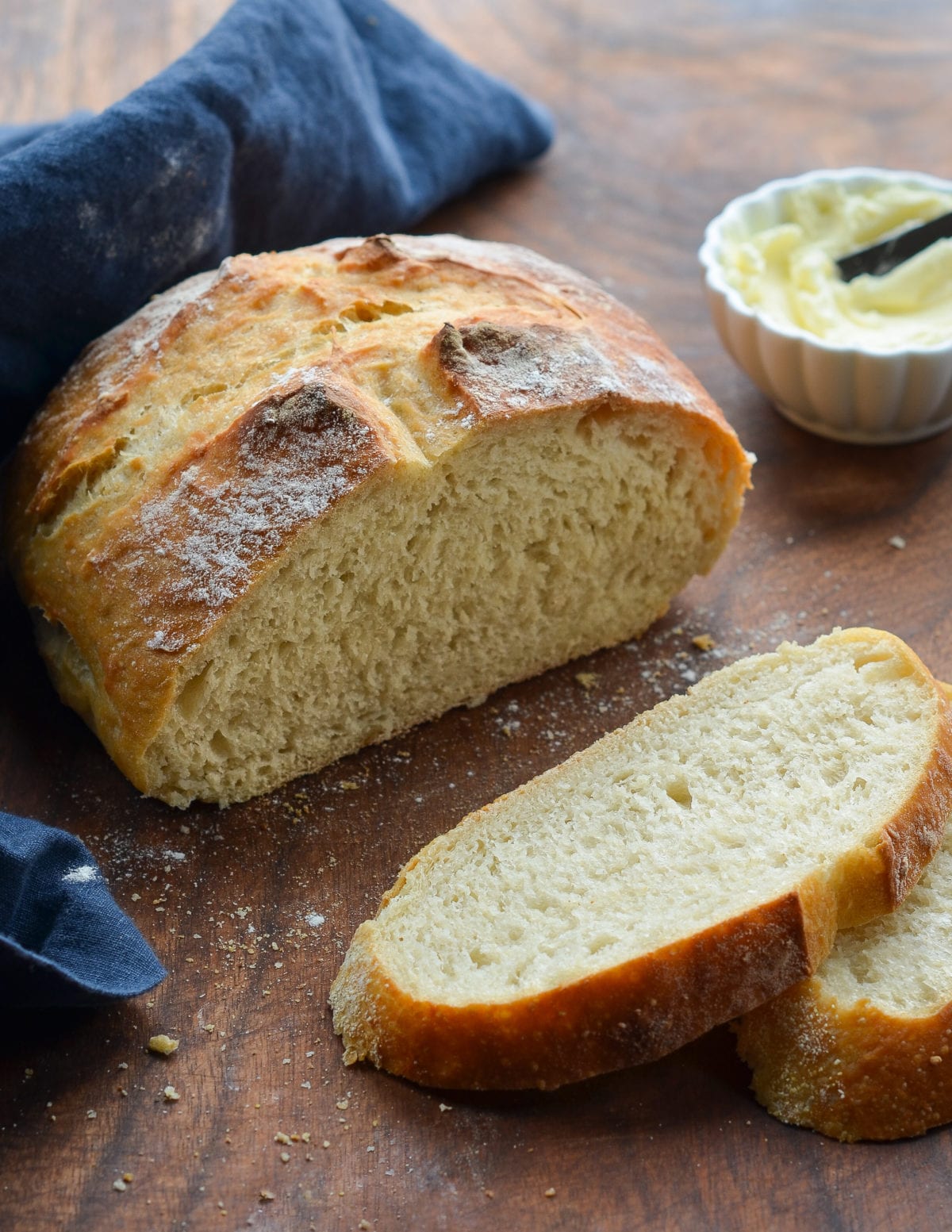
You May Also Like
Crusty Artisan Bread
This crusty bread recipe is astonishingly easy—no kneading required—and makes three beautiful loaves, which you can bake as needed.
Ingredients
- 6½ cups all-purpose flour, spooned into measuring cup and leveled-off (preferably King Arthur; see note)
- 4 teaspoons kosher salt
- 1½ tablespoons instant/rapid-rise yeast (see note)
- 3 cups lukewarm water (no need to be exact but lukewarm is about 100°F)
- Cornmeal, for dusting the pan
Instructions
- In a very large (6-quart) bowl, whisk together the flour, salt, and yeast. Add the water and stir with a wooden spoon until the mixture is uniformly moist, without any patches of flour. The dough should be sticky and conform to the shape of the bowl. If your dough is too dry, add a few tablespoons more warm water. If it's too wet, add a few tablespoons of flour. (See the step-by-step photos for guidance on what the dough should look like.) Cover the bowl loosely with plastic wrap and let it sit on the counter in a warm spot for 2 hours. If you plan to bake a loaf immediately, proceed to the next step. Otherwise, place the bowl of dough in the refrigerator to be used over the next 14 days. (Once refrigerated, the dough will shrink back a bit; that's okay. Do not punch down the dough at any point, and keep it loosely covered with plastic wrap.)
- Dust a sturdy baking sheet with cornmeal.
- Dust the surface of the dough and your hands lightly with flour. Pull out one-third of the dough and coat the outside lightly with flour (you don't want to incorporate more flour into the dough, you just want to be able to handle it). Gently work the dough into a smooth ball, stretching the surface and tucking the ends underneath, adding more flour as needed so it doesn't stick to your hands. (Don't overwork the dough; this process should only take about 30 seconds.) Put the dough ball onto the prepared baking sheet and let it rest at room temperature, uncovered, for about 40 minutes. (If the dough has been refrigerated, allow it to rise for 60 minutes, or up to 90 minutes if you want a more open and airy crumb structure.) The dough will rise a bit. It may also spread/flatten a bit; that's okay.
- Preheat the oven to 450°F. Set one rack in the lowest position of the oven and one rack in the middle position. Place a metal pan (any metal cake pan or broiler pan will work; just don't use glass) on the bottom rack. (You will fill this with water later to create steam in the oven).
- Generously dust the dough with flour. Using a sharp knife, make a few ½-inch-deep slashes in the dough -- a scallop, cross, or tic tac toe pattern all look nice.
- Slide the baking sheet with the dough into the oven, and carefully fill the metal cake pan with one cup of hot tap water. (Try to do this quickly so as not to let heat out of the oven.) Bake until the loaf is golden brown, about 30 minutes. Cool completely on a wire rack.
- This bread is best enjoyed fresh on the day it is made. Once sliced, place the loaf cut-side down on a cutting board or plate and leave it uncovered. (If it lasts beyond a day, I suggest slicing and freezing.)
- Freezer-Friendly Instructions The dough can be portioned into thirds and frozen in airtight plastic containers for up to 1 month. Defrost the dough in the refrigerator overnight, then shape, rest and bake as usual. The baked loaves can also be frozen whole or sliced: Wrap in a zip-top freezer bag and freeze for up to 1 month. (If you plan to use slices one at a time, place pieces of parchment between them so they don't stick.) To thaw, take the bread out of the freezer and let it come to room temperature on the countertop. Reheat in a 350°F oven until warmed through, about 10 minutes.
- Note: Active dry yeast may be used instead of instant/rapid-rise yeast, however, the dough will take longer to rise. To give active dry yeast a boost, you can dissolve it in the lukewarm water and let it sit until frothy, about 10 minutes. After that, add it to the flour and salt, and proceed with the recipe.
- Note: I use King Arthur flour, which is higher in protein than some other all-purpose flours. If using a flour with a lower protein content, such as Gold Medal, you will likely need to add a few more tablespoons of flour.
Nutrition Information
Powered by ![]()
- Serving size: 1 slice
- Calories: 100
- Fat: 0 g
- Saturated fat: 0 g
- Carbohydrates: 21 g
- Sugar: 0 g
- Fiber: 1 g
- Protein: 3 g
- Sodium: 64 mg
- Cholesterol: 0 mg
This website is written and produced for informational purposes only. I am not a certified nutritionist and the nutritional data on this site has not been evaluated or approved by a nutritionist or the Food and Drug Administration. Nutritional information is offered as a courtesy and should not be construed as a guarantee. The data is calculated through an online nutritional calculator, Edamam.com. Although I do my best to provide accurate nutritional information, these figures should be considered estimates only. Varying factors such as product types or brands purchased, natural fluctuations in fresh produce, and the way ingredients are processed change the effective nutritional information in any given recipe. Furthermore, different online calculators provide different results depending on their own nutrition fact sources and algorithms. To obtain the most accurate nutritional information in a given recipe, you should calculate the nutritional information with the actual ingredients used in your recipe, using your preferred nutrition calculator.

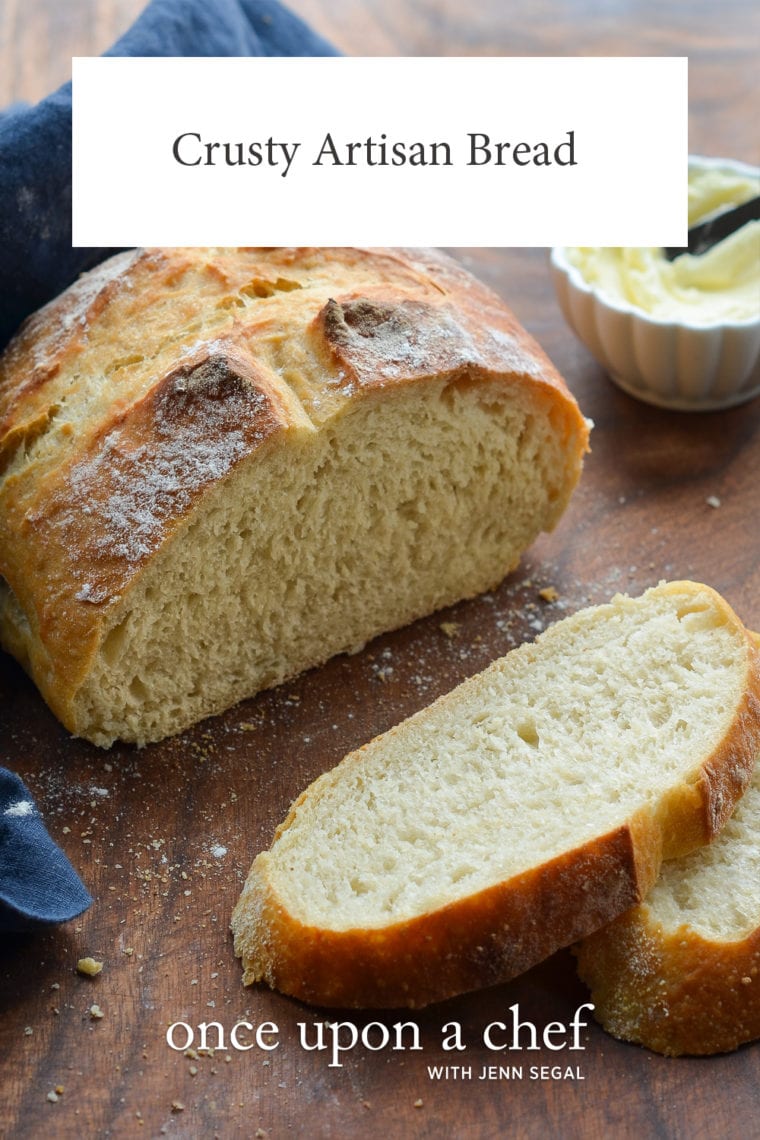
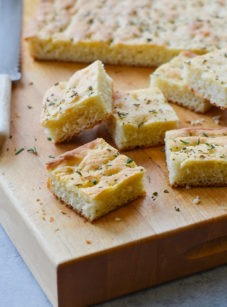
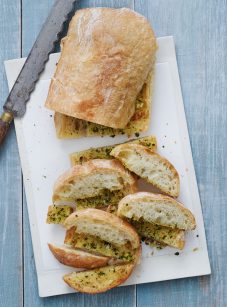
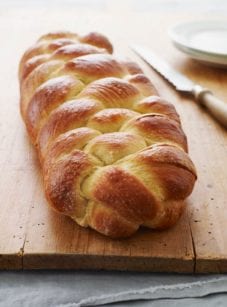
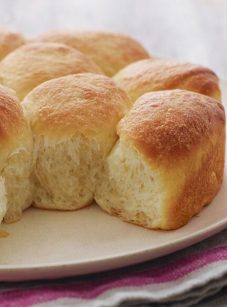
perfect recipe. im a beginner and all my bread turned out perfect!
Really tasty and quite easy! Dough is quite loose and sticky as described. My loaves tended to be really flat. They rose more during baking, but still quite a lot flatter than photos. For the second loaf I made a “pan” of foil that contained it a bit from going out so far, and that worked. Will definitely make again.
Thank you so much for this inspirational recipe. I wanted a crusty bread that didnt require kneading because i had some injections that made my arm sore. This was the perfect base! I swapped out 2/3 of the water for buttermilk, and added 1 1/2 TB basil paste and had to balance with a bit more flour but it was awesome. Adding my version to my blog, madtastes.com thanks again. Delicious!!!
This came out delicious, but stuck really bad to a baking sheet even though I generously dusted with cornmeal. How can I remedy this?
Hi Nate, Sorry you had a problem with the bread sticking! Next time you may want to try parchment paper or grease the baking sheet with nonstick cooking spray.
Can I make this in a bread pan? How much dough would I use?
Hi Kimberly, what size pan are you referring to?
12 x 4.5 x 3
Hi Kimberly, I think you could definitely try it but I’m not sure how much dough you’ll need. I’d fill the bread pan about halfway and keep a close eye on it while it’s in the oven. Hope that helps!
Hi, just wondering would it be ok to add a sachet of fast action dried yeast ( 7 g in a sachet ) straight into the mix ? Thanks.
Hi Diane, that doesn’t sound like enough yeast — the recipe calls for 1-1/2 tablespoons which is more than 7 grams. Sorry!
Hello I made your Artisan bread recipe it turned out perfect. Thank you so much. I am a fan of yours love watching new recipes
Chef Cindy L Jones
Hi Jenn,
We just got a new convection oven and can’t wait to try this, but we do have one question. Would convection method (with its tendency to brown) work well or would we be better off sticking to conventional baking for this?
Hi Robert, I always develop and publish my recipes using the regular setting on my oven (because many people don’t have convection settings on their ovens), so I’d go with the regular/non-fan setting. If you really want to use the convection setting, I’d reduce the baking temp by 25°F. Hope you enjoy!
Not sure where you live, but in a humid climate, I cut the recipe into thirds and had to add over a 1/2 cup of flour to make it even slightly workable, which , of course, ruined the bread because it was overworked. If you look at the original recipe by King Arthur Flour, they call for an additional cup of flour for the 3 cups of water you use. I would not try this in summer or a warmer climate without adding a solid C of flour to the original recipe.
We live in the Amazon and my dough no matter what I try is a giant sloppy mess and never looks like the pictures. However, my family loves it, despite the fact it is pretty flat, haha. The taste and texture is still really good after its baked!
hi jenn. Is it possible to divide this in smaller portions? I was thinking like ciabatta roll size?
Sure!
Hi Jenn – I tried this recipe about three weeks ago and have made it three separate times since. We’ve had no problem polishing off a loaf before looking forward to the next. It’s absolutely delicious and something to be proud of. I’ve gifted a loaf or two to neighbors, and they’ve loved it, too. (What’s not to like!) I’m amazed at how so few ingredients deliver such a wonderful product. Many thanks for another superb recipe!
BTW, may I ask a question about the cinnamon swirl bread from your cookbook? I made it last week and was so proud of my finished product. It’s beautiful, absolutely delicious. I will make it many times in the future and plan to give it as a gift over Christmas. My question is after baking for just 35 minutes, the top crust was a little dark and even though it was cooked perfectly, the absolute center was slightly under baked. It would have been much too dark if I left it in the oven longer. Looking forward to your thoughts.
Glad you’ve enjoyed the bread! For the cinnamon swirl bread, next time you bake it, add an extra 5 minutes to the baking time but once you see it getting golden brown on top, lay a piece of foil loosely over it to keep it from browning too much. Hope that helps!
Thank you for your speedy reply, Jenn. I will do exactly as you suggested. BTW, I appreciate your recipes as much as I enjoy the education you provide. I’m also enjoying your 5 Secrets emails. I’m not sure how you do it all, but here’s a heartfelt thank you for making me a better cook!